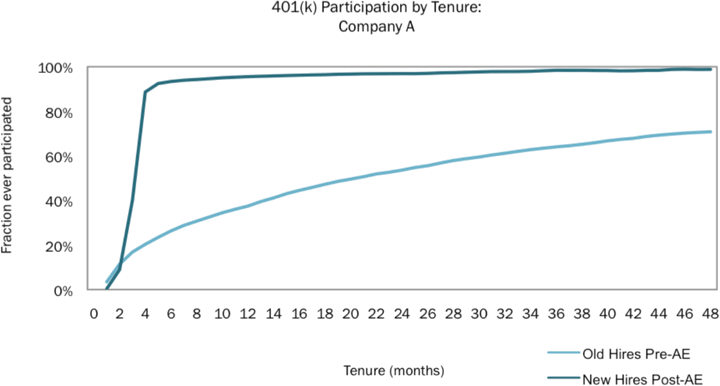A new ProPublica article by Lena Groeger discusses the power of default settings in our life – from organ donations to computer font settings. Included was an interesting case study of a company who implemented automatic enrollment into the company 401(k) for new employees. Here’s the drastic difference in the 401(k) participation rate (vs. time at company) for the two groups, auto-enrolled (AE) and not:

Keep in mind, in both cases the employees could have changed their participation status at any time. No change was ever required, only the default initial setting was changed.
The study cited also points out the auto-enrolled default settings could also make some employees save less than they would have otherwise. For example, if the initial deferred percentage is only set at a 2% savings rate however, many people will just stick to that number whereas if they picked on their own it would be higher. People may believe the default setting to be the “expert recommended” or “popular” choice.
The same thing applies for escalation of savings over time. If there is no auto-escalation feature that increases the savings rate as income increases, some people will stay at the initial default savings setting for years or decades.
Suggested Best Practices. By combining their findings, the following best practices are presented as an example.
- Auto enroll all current and future employees into the plan.
- Set the initial deferral percentage at no less than 6 percent.
- Employ an automatic increase of a 1 or 2 percent deferral rate, to a maximum of no less than 15 percent.
Most of have a lot of great goals (eat better, save more, waste less time), but it will always be hard to make the best decisions all the time. We should respect the power of default settings, and use the same concept to help keep us on the right path for the future. For example, at our company retirement plan, we have an auto-escalation feature but we must opt-in manually. If I invest the energy to turn that option on today, we’ll have a better default for future years, knowing we might get lazy in the future.
 The Best Credit Card Bonus Offers – July 2024
The Best Credit Card Bonus Offers – July 2024 Big List of Free Stocks from Brokerage Apps
Big List of Free Stocks from Brokerage Apps Best Interest Rates on Cash - July 2024
Best Interest Rates on Cash - July 2024 Free Credit Scores x 3 + Free Credit Monitoring
Free Credit Scores x 3 + Free Credit Monitoring Best No Fee 0% APR Balance Transfer Offers
Best No Fee 0% APR Balance Transfer Offers Little-Known Cellular Data Plans That Can Save Big Money
Little-Known Cellular Data Plans That Can Save Big Money How To Haggle Your Cable or Direct TV Bill
How To Haggle Your Cable or Direct TV Bill Big List of Free Consumer Data Reports (Credit, Rent, Work)
Big List of Free Consumer Data Reports (Credit, Rent, Work)
Speak Your Mind